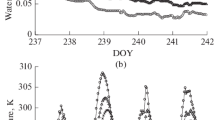Abstract
Vertical flux densities of ammonia, water vapour and sensible heat were measured over a flooded rice field in China following the application of ammonium bicarbonate fertilizer. Aqueous and gaseous phase transfer resistances for ammonia were deduced from these measurements. The aqueous phase resistance was maximal in the morning and least in the afternoon. Stable stratification of the floodwater immediately adjacent to the air-water interface was observed during the morning when evaporation rates were low, and may be responsible for inhibiting the transfer of ammonia to the atmosphere.
Similar content being viewed by others
References
Bouwmeester, R. J. B. and Vlek, P. L. G., 1981, Rate control of ammonia volatilization from rice paddies, Atmos. Environ. 15, 131–140.
Cai, G. X., Zhu, Z. L., Trevitt, A. C. F., Freney, J. R., and Simpson, J. R., 1986, Nitrogen loss from ammonium bicarbonate and urea fertilizers applied to flooded rice, Fert. Res. 10, 203–215.
Deacon, E. L., 1977, Gas transfer to and across an air-water interface, Tellus 29, 363–374.
De, Datta, S. K., 1981, Principles and Practices of Rice Production, John Wiley, New York.
Denmead, O. T., 1983, Micrometeorological methods for measuring gaseous losses of nitrogen in the field, in J. R., Freney and J. R., Simpson (eds.), Gaseous Loss of Nitrogen from Plant-Soil Systems. Martinus Nijhoff/Dr W. Junk Publishers, The Hague, pp. 133–157.
Denmead, O. T., Simpson, J. R., and Freney, J. R., 1977, A direct field measurement of ammonia emission after injection of anhydrous ammonia, Soil Sci. Soc. Am. J. 41, 1001–1004.
Denmead, Q. T., Freney, J. R., and Simpson, J. R., 1982, Dynamics of ammonia volatilization during furrow irrigation of maize, Soil Sci. Sco. Am. J. 46, 149–155.
Denmead, O. T., Trevitt, A. C. F., Muirhead, W. A., Freney, J. R., and Simpson, J. R., 1987. Modelling ammonia loss from flooded soil systems, in P. E. Bacon and J. Evans (eds.), Nitrogen Cycling in Agricultural Systems of Temperate Australia. Proceedings of Australian Soil Science Society conference, Wagga Wagga, July 14–16, 1986.
De, Vries, D. A., 1963, Thermal properties of soils, in W. R.Van, Wijk (ed.), Physics of Plant Environment, North-Holland, Amsterdam, pp. 210–235.
Fillery, I. R. P., Simpson, J. R., and De, Datta, S. K., 1984, Influence of field environment and fortilizer management on ammonia loss from flooded rice, Soil Sci. Soc. Am. J. 48, 914–920.
Freney, J. R., Denmead, O. T., Watanabe, I., and Craswell, E. T., 1981. Ammonia and nitrous oxide losses following applications of ammonium sulfate to flooded rice, Aust. J. Agric. Res. 32, 37–45.
Freney, J. R., Leuning, R., Simpson, J. R., Denmead, O. T., and Muirhead, W. A., 1985, Estimating ammonia volatilization from flooded rice fields by simplified techniques, Soil Sci. Soc. Am. J. 49, 1049–1054.
Freney, J. R., Trevitt, A. C. F., Zhu Z. L., Cai, G. X., and Simpson J. R., 1987, Assessing ammonia volatilization from fertilizer nitrogen applied to flooded rice fields, Acta Pedoiogica Sinica, (in press).
Hales, J. M., and Drewes, D. R., 1979, Solubility of ammonia in water at low concentrations, Atmos. Environ. 13, 1133–1147.
Leuning, R., Denmead, O. T., Simpson, J. R., and Freney, J. R., 1984, Processes of ammonia loss from shallow floodwater, Atmos. Environ. 18, 1583–1592.
Li, C. K. and Chen, R. Y., 1980, Ammonium biearbonate used as a nitrogen fertilizer in China, Fert. Res. 1, 125–136.
Liss, P. S., 1973, Processes of gas exchange across and air-water interface, Deep-Sea Res. 20, 221–238.
Liss, P. S. and Slater, P. G., 1974, Flux of gases across the air-sea interface, Nature 247, 181–184.
Moeller, M. B. and Vlek, P. L. G., 1982, The chemical dynamics of ammonia volatilization from aqucous solution, Atmos. Environ. 16, 709–717.
Oke, T. R., 1978, Boundary Layer Climates, Methuen, New York.
Rose, C. W. and Chapman, A. L., 1968, A physical analysis of diurnal temperature regimes in clear and turbid water layers: a problem in rice culture, Agric. Met. 5, 391–409.
Van, Wijk, W. R. and De, Vries, D. A., 1963, Periodic temperature variations in a homogeneous soil, in W. R.Van, Wijk (ed.), Physics of Plant Environment, North-Holland, Amsterdam, pp. 102–143.
Author information
Authors and Affiliations
Rights and permissions
About this article
Cite this article
Trevitt, A.C.F., Freney, J.R., Denmead, O.T. et al. Water-air transfer resistance for ammonia from flooded rice. J Atmos Chem 6, 133–147 (1988). https://doi.org/10.1007/BF00048336
Received:
Revised:
Issue Date:
DOI: https://doi.org/10.1007/BF00048336




